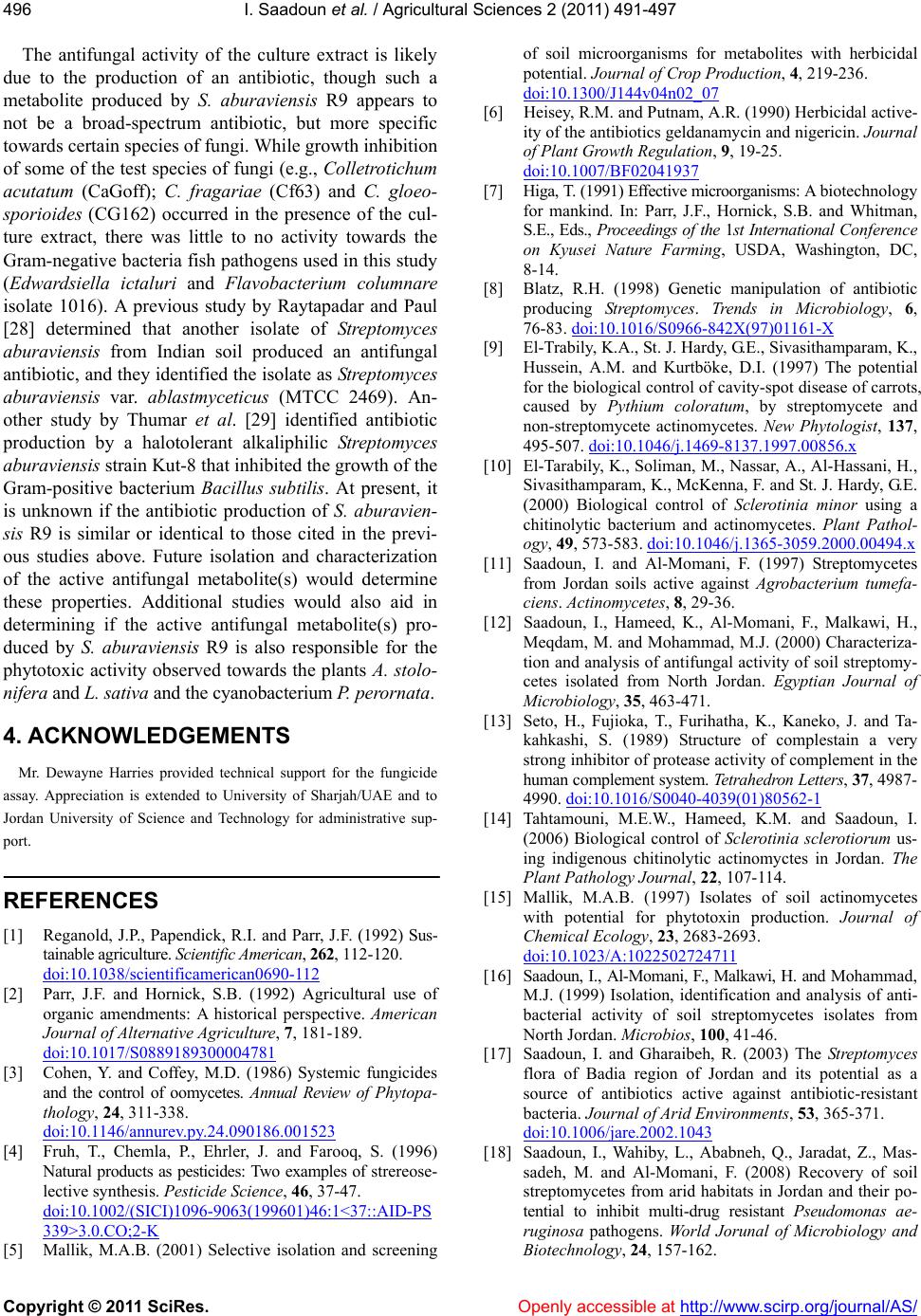
I. Saadoun et al. / Agricultural Sciences 2 (2011) 491-497
Copyright © 2011 SciRes. Openly accessible at http://www.scirp.org/journal/AS/
496
The antifungal activity of the culture extract is likely
due to the production of an antibiotic, though such a
metabolite produced by S. aburaviensis R9 appears to
not be a broad-spectrum antibiotic, but more specific
towards certain species of fungi. While growth inhibition
of some of the test species of fungi (e.g., Colletrotichum
acutatum (CaGoff); C. fragariae (Cf63) and C. gloeo-
sporioides (CG162) occurred in the presence of the cul-
ture extract, there was little to no activity towards the
Gram-negative bacteria fish pathogens used in this study
(Edwardsiella ictaluri and Flavobacterium columnare
isolate 1016). A previous study by Raytapadar and Paul
[28] determined that another isolate of Streptomyces
aburaviensis from Indian soil produced an antifungal
antibiotic, and they identified the isolate as Streptomyces
aburaviensis var. ablastmyceticus (MTCC 2469). An-
other study by Thumar et al. [29] identified antibiotic
production by a halotolerant alkaliphilic Streptomyces
aburaviensis strain Kut-8 that inhibited the growth of the
Gram-positive bacterium Bacillus subtilis. At present, it
is unknown if the antibiotic production of S. aburavien-
sis R9 is similar or identical to those cited in the previ-
ous studies above. Future isolation and characterization
of the active antifungal metabolite(s) would determine
these properties. Additional studies would also aid in
determining if the active antifungal metabolite(s) pro-
duced by S. aburaviensis R9 is also responsible for the
phytotoxic activity observed towards the plants A. stolo-
nifera and L. sativa and the cyanobacterium P. perornata.
4. ACKNOWLEDGEMENTS
Mr. Dewayne Harries provided technical support for the fungicide
assay. Appreciation is extended to University of Sharjah/UAE and to
Jordan University of Science and Technology for administrative sup-
port.
REFERENCES
[1] Reganold, J.P., Papendick, R.I. and Parr, J.F. (1992) Sus-
tainable agriculture. Scientific American, 262, 112-120.
doi:10.1038/scientificamerican0690-112
[2] Parr, J.F. and Hornick, S.B. (1992) Agricultural use of
organic amendments: A historical perspective. American
Journal of Alternative Agriculture, 7, 181-189.
doi:10.1017/S0889189300004781
[3] Cohen, Y. and Coffey, M.D. (1986) Systemic fungicides
and the control of oomycetes. Annual Review of Phytopa-
thology, 24, 311-338.
doi:10.1146/annurev.py.24.090186.001523
[4] Fruh, T., Chemla, P., Ehrler, J. and Farooq, S. (1996)
Natural products as pesticides: Two examples of strereose-
lective synthesis. Pesticide Science, 46, 37-47.
doi:10.1002/(SICI)1096-9063(199601)46:1<37::AID-PS
339>3.0.CO;2-K
[5] Mallik, M.A.B. (2001) Selective isolation and screening
of soil microorganisms for metabolites with herbicidal
potential. Journal of Crop Production, 4, 219-236.
doi:10.1300/J144v04n02_07
[6] Heisey, R.M. and Putnam, A.R. (1990) Herbicidal active-
ity of the antibiotics geldanamycin and nigericin. Journal
of Plant Growth Regulation, 9, 19-25.
doi:10.1007/BF02041937
[7] Higa, T. (1991) Effective microorganisms: A biotechnology
for mankind. In: Parr, J.F., Hornick, S.B. and Whitman,
S.E., Eds., Proceedings of the 1st International Conference
on Kyusei Nature Farming, USDA, Washington, DC,
8-14.
[8] Blatz, R.H. (1998) Genetic manipulation of antibiotic
producing Streptomyces. Trends in Microbiology, 6,
76-83. doi:10.1016/S0966-842X(97)01161-X
[9] El-Trabily, K.A., St. J. Hardy, G.E., Sivasithamparam, K.,
Hussein, A.M. and Kurtböke, D.I. (1997) The potential
for the biological control of cavity-spot disease of carrots,
caused by Pythium coloratum, by streptomycete and
non-streptomycete actinomycetes. New Phytologist, 137,
495-507. doi:10.1046/j.1469-8137.1997.00856.x
[10] El-Tarabily, K., Soliman, M., Nassar, A., Al-Hassani, H.,
Sivasithamparam, K., McKenna, F. and St. J. Hardy, G.E.
(2000) Biological control of Sclerotinia minor using a
chitinolytic bacterium and actinomycetes. Plant Pathol-
ogy, 49, 573-583. doi:10.1046/j.1365-3059.2000.00494.x
[11] Saadoun, I. and Al-Momani, F. (1997) Streptomycetes
from Jordan soils active against Agrobacterium tumefa-
ciens. Actinomycetes, 8, 29-36.
[12] Saadoun, I., Hameed, K., Al-Momani, F., Malkawi, H.,
Meqdam, M. and Mohammad, M.J. (2000) Characteriza-
tion and analysis of antifungal activity of soil streptomy-
cetes isolated from North Jordan. Egyptian Journal of
Microbiology, 35, 463-471.
[13] Seto, H., Fujioka, T., Furihatha, K., Kaneko, J. and Ta-
kahkashi, S. (1989) Structure of complestain a very
strong inhibitor of protease activity of complement in the
human complement system. Tetrahedron Letters, 37, 4987-
4990. doi:10.1016/S0040-4039(01)80562-1
[14] Tahtamouni, M.E.W., Hameed, K.M. and Saadoun, I.
(2006) Biological control of Sclerotinia sclerotiorum us-
ing indigenous chitinolytic actinomyctes in Jordan. The
Plant Pathology Journal, 22, 107-114.
[15] Mallik, M.A.B. (1997) Isolates of soil actinomycetes
with potential for phytotoxin production. Journal of
Chemical Ecology, 23, 2683-2693.
doi:10.1023/A:1022502724711
[16] Saadoun, I., Al-Momani, F., Malkawi, H. and Mohammad,
M.J. (1999) Isolation, identification and analysis of anti-
bacterial activity of soil streptomycetes isolates from
North Jordan. Microbios, 100, 41-46.
[17] Saadoun, I. and Gharaibeh, R. (2003) The Streptomyces
flora of Badia region of Jordan and its potential as a
source of antibiotics active against antibiotic-resistant
bacteria. Journal of Arid Environments, 53, 365-371.
doi:10.1006/jare.2002.1043
[18] Saadoun, I., Wahiby, L., Ababneh, Q., Jaradat, Z., Mas-
sadeh, M. and Al-Momani, F. (2008) Recovery of soil
streptomycetes from arid habitats in Jordan and their po-
tential to inhibit multi-drug resistant Pseudomonas ae-
ruginosa pathogens. World Jorunal of Microbiology and
Biotechnology, 24, 157-162.